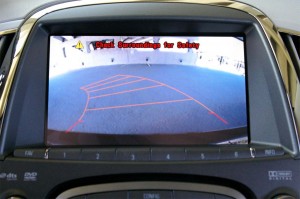Advancing autumn darkness increases concerns about pedestrian safety and one innovation that does help reduce accidents is the back-up camera, according to studies by AAA.
On average, these rear-view systems improved visibility an average of 46%, the travel and safety organization found. That’s a significant improvement, and something that can save 100s of lives a year, which is why federal regulators will beginning mandating the technology a year from now.
“Rear-view cameras are a great supplement for drivers,” says John Nielsen, AAA’s managing director of Automotive Engineering.
“Cameras don’t replace the need to check around your vehicle for obstacles before getting in to back up, but they do dramatically improve rear visibility,” he adds. “These systems are especially helpful for viewing the first 10 feet behind the vehicle, which are the most hazardous in terms of back-over risk for young children,” he said.
(Infotainment systems are a “plague” on the auto industry, warns Consumer Reports. Click Here for more.)
Of the average 292 people killed each year in back-up accidents, the National Highway Traffic Safety Administration estimated 100 are children under the age of five. Another 18,000 people are injured. NHTSA estimates using cameras could reduce the death toll to between 95 and 112 annually, while also preventing as many as 8,374 injuries.
After an extensive delay, the federal agency finally announced new rules this past year that will begin requiring the use of back-up cameras for 2017 model-year vehicles. The phased-in plan will cover all passenger vehicles produced by May 2018.
Back-up cameras are already coming into widespread use. The technology will be standard on the 2015 Ford Mustang, for example. But researchers say there is significant difference between the various systems now on the market.
(Are limited “geographic recalls” putting millions of American motorists at risk? Click Here to find out.)
AAA evaluated 17 vehicles from 11 different manufacturers equipped with factory-installed and aftermarket rear-view camera systems, testing a variety of vehicle body styles to measure the reduction in blind-zone areas as a direct result of using the technology.
AAA’s research – conducted at the Automobile Club of Southern California’s Automotive Research Center – found that, on average, a rear-view camera system increased visibility of the rear blind-zone area by an average of 46% for the vehicles tested.
The improvement ranged from a 36% improvement in smaller sedans to a 75% improvement in hatchbacks.
But while the systems improve rear-view visibility, they do not show 100% of the space behind the vehicle, the organization warns. AAA recommends drivers always walk behind their vehicle to visually confirm that there are no obstacles, and use a rear-view camera to confirm that nothing has entered the area immediately behind the vehicle since the driver’s walk-through inspection.
(Gas prices falling to four-year low. Click Here for the story.)
In addition, the systems are sensitive to weather conditions. Rain, snow or slush can cloud the rear-view camera lens, delivering blurry imagery. Motorists will need to check that the rear blind zone is clear during inclement weather, the AAA study found. Wiping the camera during the pre-drive inspection is a good habit that ensures the camera is ready to capture a clear image, AAA says.
“As Halloween approaches, we know that neighborhoods will be filled with small trick-or-treaters that could easily be missed when the driver turns his head to look behind the vehicle,” says Nielsen. “When used appropriately, a rear-view camera offers a bright, clear view directly behind the vehicle where small children are most difficult to see.”
(Paul A. Eisenstein contributed to this report.)


While the rear view cameras do improve rear vision IME people who use them often forget to check the sides of the vehicle when backing up.
The rearview camera on my new VW Passat, like the one on the Hyundai Genesis I drove last month, have guide marks to show your clearance and tell you exactly how close you can get to both rear and side. The heavily optioned Chevy Malibu I drove last week just has a screen with no guides at all overlaid on the image. I found it not nearly as useful. Was this to save 50¢ on the system?
Fred, I also greatly prefer having those guidelines — all the more so when they turn to reflect the angle of the steering wheel as you back up. I can tell you that Toyota long did not offer that feature because they were afraid they would have to pay something else for the patent rights. They decided they could get around the patent and have been phasing the feature in. GM has it on some models, not others, and I think its absence makes a backup system far less effective.
Paul E.